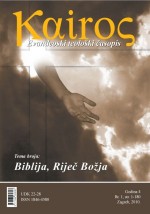Želudac, ruke, noge, stopala, oči, uši, usta, gornji i donji zubi, kutnjaci, obrve i glava: Jedinstvo kršćana i drevni topos tijela i udova
Stomach, Hands, Legs, Feet, Eyes, Ears, Mouth, Upper and Lower Teeth, Molars, Eyebrows and Head: The Unity of Christians and the Ancient Topos of Body
Author(s): Davorin PeterlinSubject(s): Christian Theology and Religion
Published by: Biblijski institut
Keywords: topos; body; head; members; body of Christ; Church; Corinthians; ecclesiology; Paul; Clement
Summary/Abstract: This article stems from the question of the source from which the Christian author Paul took the image of the body and its members and its head. This image appears in several forms in Paul’s first letter to the Corinthians as well as in Romans, Colossians and Ephesians. The author asks how Paul used it when addressing the issue of the relationships among believers in the church as well as the relationship between the church and Christ. The author maintains that Paul adopted and adapted the ancient topos of the body and its members which appears in many authors from Classical and Hellenistic times, as in Stoic texts of Paul’s era. The key texts are reproduced in Croatian translation. Against these sources the author investigates how Clement of Rome used the same topos. The author concludes that ancient writers adjusted the topos to the aims of their texts and messages. The same applies to the aforementioned hristian writers. Of the two, Paul adapted and developed (more thoroughly than did Clement) the ancient topos to the Christian teaching about the church, and filled it with theological meaning.
Journal: Kairos: Evanđeoski teološki časopis
- Issue Year: 4/2010
- Issue No: 1
- Page Range: 75-92
- Page Count: 17
- Language: Croatian

